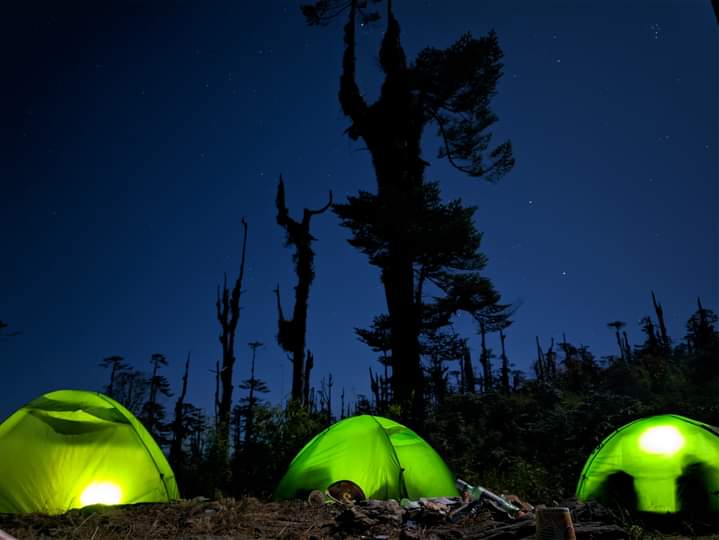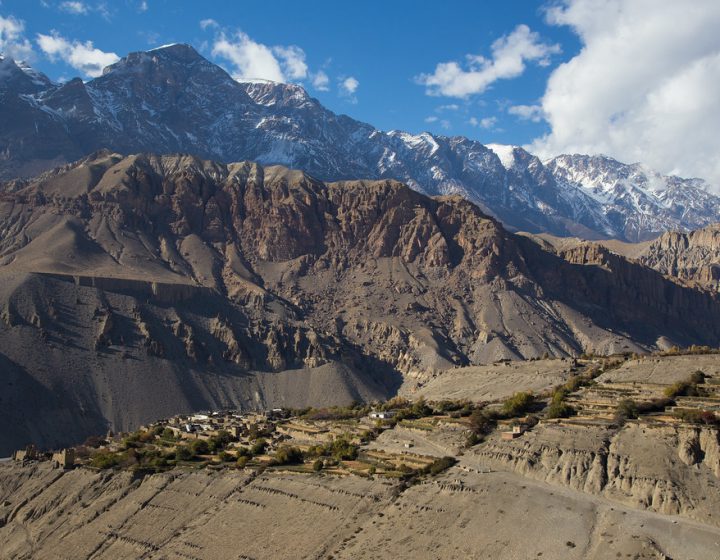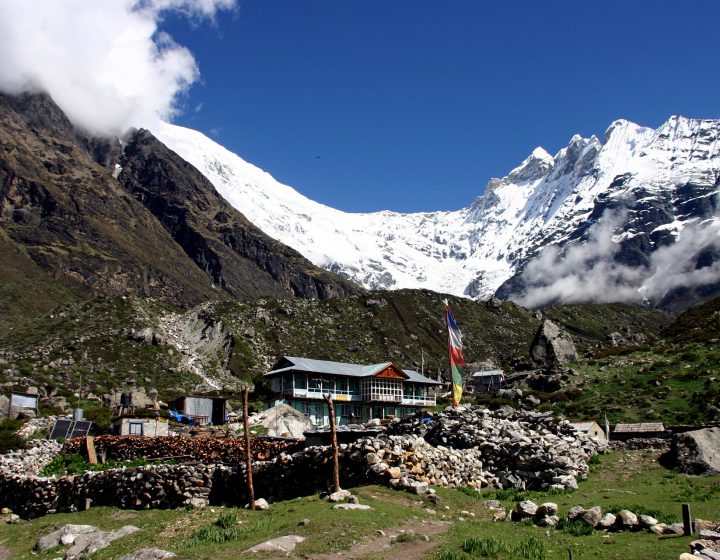Tour overview
The Mount Everest (Khumbu) region is the most popular trekking area in Nepal. Everest Base Camp Trek includes the highest Mountain of the world, Mount Everest (8848m) and many peaks of altitude above 8000m, such as Lhotse, Cho Oyu and Makalu. This trek is the grandest walk in the land of the Himalayas. The Everest Base Camp Trek is not only famous for its world’s highest mountains but also for its high mountain picturesque villages, friendly Sherpa people, Sherpa culture, traditions and the monasteries. The Himalayan floras and faunas are other ornaments of the Sagarmatha National Park. The story of the Yeti, which is still mystery in the world, is also from the Khumbu region. It is an opportunity to embark on an epic journey that Sir Edmund Hillary and Tenzing Norgay set off on in 1953. The main goal of Everest trek is Everest Base Camp at an elevation of 5364m. We can’t see Everest from the base camp, so we climb to Kala Patthar, a 5545m bump on the southern flank of Pumori (7165m), from there is a dramatic view of Everest and many other mountains.
The Everest Base Camp Trek start from Lukla, takes you through lush green valley with rich floras and faunas, past friendly Sherpa villages and Buddhist monasteries, and far above the tree line towards the world’s highest mountains. Ama Dablam, Lhotse, Nuptse, Everest and Pumori tower above you.
Trip Facts:
Duration: 16 days
Grade: Strenuous
Maximum elevation: 5545m
Best season: October to December – March to May
Hotels: Excellent
Group size: 2 +
Trip Highlights:
*Mountain flight to Lukla
*Views of Everest and Khumbu Ice fall from Kala pathar
*Close views of Ama Dablam and several high Himalayan Peaks
*Tengboche monastery
*Namche Bazaar – Sherpa heartland
Day 1: Arrive in Kathmandu (1350m)
Our representative will meet you outside the customs and immigration area at the airport. He or She will brief you on the immediate arrangements and escort you to your hotel. The trip leader will hold a short briefing in the hotel regarding trek arrangements and general orientation to Kathmandu.
Day 2: Sightseeing in Kathmandu Valley
Today, we visit the most historical and Spiritual attractions in Kathmandu which are also listed in world heritage sites. We visit Durbar Square, Swayambhunath (Monkey temple), Bouddhanath, which is one of the largest Stupa in the world and the sacred Hindu temple of Pashupatinath.
Day 3: Fly to Lukla (2800m / 40 min) and Trek to Phakding (2640m / 4 hrs)
Early in the morning we have spectacular 40 min flight from Kathmandu to Lukla, a gateway destination from where we stat our trek. This is one of the most beautiful air routes in the world, Much of it is only a few hundred feet above the ground and the views of the rivers, valleys and terraced landscapes below as well as the proximity of some of the world's highest mountains make it a memorable experience. Upon arrival at Lukla airport, we meet our crew members and after packing and arrangements we start our trek.
We walk through Lukla village, the trail drops steeply for a while then descends gently past the Chaurikharka to the intersection of Jiri trail at Chheplung. We cross a stream, pass few lodges then descend steeply to the Thado Khola. We can see Kusum Kangru peak at the head of the valley. After crossing the river by suspension bride, the trail climbs a bit then contours around a ridge to Ghat, on the banks of the Dudh Koshi. Cross a ridge marked with painted Mani stones and climb a bit above the river then descend a stone staircase to a hotel. The trail climbs again to Phakding, a huge collection of lodges.
Day 4: Trek to Namche Bazaar (3440m / 5-6 hrs)
After crossing Dudh Koshi at Phakding, we continue north up the Dudh Koshi valley, pass several new lodges and small villages, arrive in Waterfall. A short distance beyond the waterfall we have excellent view of Thamserku peak (6618m). Climb steeply over a rocky ridge then traverses high above the river to Benkar. Beyond Benkar we cross the Dudh Koshi River and follow a pleasant route along the river side then climb to Chumoa. From here we descend steeply into a big valley, cross a stream and climb out of the valley to Monjo. Just beyond the Monjo there is a Sagarmatha National Park check post, the National Park staffs check our permit. From here we enter into the National Park region. From the check post, we descend to a large farm, turn left at the cluster of buildings at the bottom of the hill, cross the Dudh Koshi river on high bridge and follow the west bank to Jorsale. After Jorsale, we follow the river for a while and cross the Dudh Koshi River, follow the river bank then make a steep climb near the confluence of Bhote and Dudh Koshi River then cross the Dudh Koshi on a suspension bridge. From the bridge, it starts long steep climb up to the Namche. After long climb up switchbacks through beautiful forest, there is a view point of Mt. Everest peering over the ridge of Nuptse. Leaving the ridge, the trail climbs less steep but still steady through Pine forest to Mishulung. From small stream we take the right, upper trail to reach the main street of Namche Bazaar. This is the main trade centre of Khumbu region and gateway to Mt. Everest. In the centre of the Namche the Sagarmatha Pollution Control Committee (SPCC) has information centre.
Day 5: Acclimatization Day
Today we hike to Syangboche (3720m), steep climb for little bit more than 1 hr to Syangboche airstrip. There are few hotels and teashops near the airstrip. We walk about 20 minutes further to Everest view hotel which provides excellent views of Everest and Ama Dablam. Or relaxing and exploring Namche Bazaar, here are government offices, ATMS, Internet cafes, many shops, restaurants, bakery and colorful market.
Day 6: Trek to Tengboche (3860m / 6 hrs)
Leaving Namche, we follow more or less smooth trail with few ups and downs to Kyangjuma and then Sanasa, which is the trail junction to Gokyo valley and Everest Base Camp. We have magnificent view of the Himalayas and we can see Musk deer, Himalayan Thar and colorful pheasants along the way. The route follows through the pine forest, descend gradually then drop steeply, cross the prayer flags festooned bridge over the Dudh Koshi River, we reach at Phunki Thanga, a small settlement with several teahouse, several water-driven prayer wheels and a small army post amidst the alpine woods. From Phunki Thanga, the trail climbs steeply at first then makes gradual ascend through beautiful forest of pine and rhododendron to Tengboche. The biggest monastery of the Khumbu region sits at 3870m, in a clearing surrounded by dwarf firs and rhododendrons. This is a great place, the view from this spot is one of the most magnificent in the world. Kwangde (6187m), Taboche (6542m), Everest, Nuptse (7879m), Lhotse (8501m), Ama Dablam (6814m), Kangtega (6783m) and Thamserku (6618m) provide an inspiring panorama of Himalayan giants. Here are some lodges. We visit the monastery in the afternoon.
Day 7: Trek to Pheriche (4240m / 5-6 hrs)
From Tengboche it is a short steep descend to Deboche through beautiful forest, there are some hotels and monastery. From Deboche the level trail passes many Mani walls in a deep rhododendron forest. After crossing the Imja Khola on a steel bridge, the route climbs past some magnificently carved Mani stones to Pangboche at 3930m. Just before the village are two Chhortens and a Kani. Pangboche is the highest year round settlement in the valley, here are several hotels. We have fantastic view of Ama Dablam. The Pangboche monastery is the oldest in Khumbu valley. Beyond Pangboche, we enter alpine meadows above the tree line. We walk through Shomare the trail passes several Yak herders huts and ascend above the river to Orsho. Beyond Orsho (confluence of the Lobuche River) the trail divides. The lower trail leads to Dingboche, the trail to Pheriche goes up to the left over a stone wall and climbs a small ridge then descend to the Khumbu Khola. After crossing the bridge it is very easy short walk to Pheriche. Pheriche is a labyrinth of walls and pastures. There are several lodges and a trekker's aid post operates supported by the Himalayan Rescue Association. This is very cold place.
Day 8: Trek to Lobuche (4930m / 5 hrs)
From Pheriche the trail ascends the broad, gently sloping valley to Phulang Karpo. In many places we cross small streams on boulders. The view of Tawache and Cholatse are superb, the top of Kangtega is visible far to the left saddle. After Phulang Karpo, we climb steeply onto the terminal moraine of the Khumbu Glacier, the contour down to a stream. Crossing it on bridge, we arrive in Duglha (4620m). There are several hotels, it is good place for little early lunch. From Duglha we climb higher on the moraine ridge top with dramatic mountain views. At the top we can see a row of stone monuments in memory of six Sherpas who died in an avalanche during the 1970 Japanese skiing expedition on Everest. There are many other monuments to climbers. We drop a bit and follow the western side of the valley to Lobuche. There are several lodges in Lobuche. During the walk we have great views of Khumbutse (6639m), Lingtren (6713m), Pumori (7165m) and Mahalangur Himal. Mt. Nuptse towers to the right as trail crosses the Khumbu Glacier.
Day 9: Trek to Gorak Shep (5160m) – Everest Base Camp (5364m) – Gorak Shep (8-9 hrs)
Leaving Lobuche we walk through the lateral moraine of the Khumbu Glacier, pass through the pyramid sign post. The ascent become steeper and rougher as it crosses several side moraines. Ahead on the trail we see crest of north ridge of Everest along with Mt. Pumori, Mahalangur, Lingtren, Khumbutse, Nuptse etc. After small ascend we reach at Thangma Riju from where we have 360 degree views of snowy peaks. We climb steeply up to the top through the torrent of Changri Glacier, we see the first glimpse of Kala Patthar, a grey-green small hill below the Mt. Pumori. We make a short descend onto the sandy, flat expanse of Gorak Shep. We have wonderful snow capped mountains all around us.
After lunch and rest, we take the trail to Everest Base Camp through the Gorak Shep Lake. Normally it takes about 5-6 hrs (up-down). We continue straight ahead, come through the Indian army mountaineers memorials and gently ascend to Base Camp. In spring season you can see lots of colorful tents in base camp. From base camp we can see Nuptse, Khumbutse and Pumori. We can't see Everest from here. In the late afternoon we come back down to Gorak Shep.
Day 10: Visit Kala Patthar (5545m / 4-5 hrs, up-down), back to Lobuche
The climb of Kala Patthar is one of the most rewarding parts of the trip. We start early in the morning, climb steep up the grassy slope west of the Gorak Shep at the foot of Pumori. After several hours of ascent, we reach Kala Patthar. It is marked by cairns and prayer flags. It offers super mountain panorama views (Everest, Nuptse, Lhotse, Lingtren, Khumbutse, Changtse, Pumori and several other peaks. Descend down to Gorak Shep is much easier. We have breakfast and lunch in Gorak Shep and then descend down to Lobuche in the afternoon.
Day 11: Trek to Dingboche (4410m / 3 - 4 hrs)
Coming back to Dingboche, we retrace our steps back to Duglha then go straight up the hill from the bridge to reach an upper trail, staying high above the valley floor, pass the Yak pasture at Dusa to a Chhorten at the head of the Imja Khola valley. We can see the great views of Island Peak, Makalu is the greenish-grey peak visible in the distance over the pass to the right of Island Peak. From Chhorten we descend, following the trail as it traverses east into the valley. Dingboche is the high pastures in this region and also know as summer village. Dingboche is a more pleasant place than Pheriche and mountain views are outstanding. In the afternoon we can make sight trip towards Chhukung.
Day 12: Trek to Tengboche (4-5 hrs)
From Dingboche we descend the Imja Khola valley then cross the Khumbu Khola on a bridge and climb little bit to rejoin the main trail near Orsho. Following the trail downhill, we visit the upper part of Pangboche and the village monastery then continue to Tengboche for the night.
Day 13: Trek to Namche Bazaar (5 – 6 hrs)
We descend to Phungi Thanga then ascend the ridge towards Namche Bazaar (Re-trace).
Day 14: Trek to Lukla (7-8 hrs)
It is a long walk from Namche to Lukla but not difficult. From Namche we descend back to the Dudh Koshi. In Jorsale, we have to show our National Park permit again and check out. From Jorsale we follow the upward route as far as Chheplung then turns off above Chaurikharka towards Lukla. In Lukla there are many good standard hotels. We celebrate last night and farewell party with our crew of our trek.
Day 15: Fly back to Kathmandu
The early morning flight brings us in Kathmandu. We can rest and relax at hotel before lunch time. After lunch we can visit nearby shops in Thamel for typical Nepalese goods shopping. In the evening we have typical Nepali food with cultural program.
Day 16: Departure to your home
We will transfer you in international airport from your hotel.



